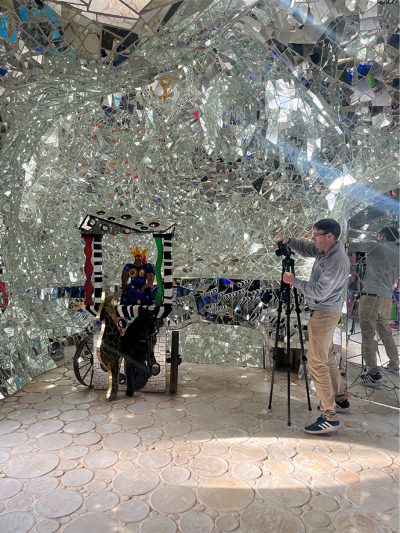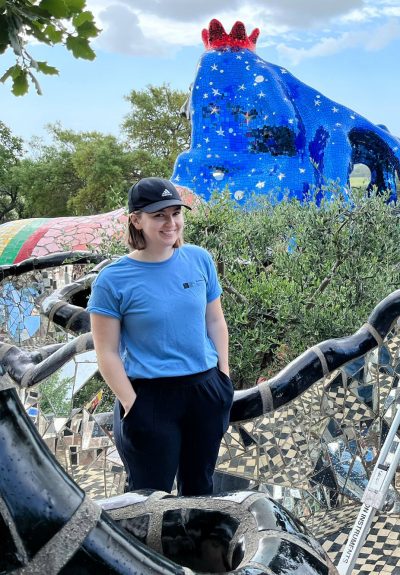Conserving Italy’s Tarot Garden for Generations to Come
CU Partners with Getty Conservation Institute to Preserve Iconic Site
Ty Burke
Carleton Immersive Media Studio
For centuries, fortune tellers have used Tarot cards to probe questions of love, loss, family and finances. The 78-card decks originated in 15th century Italy, and were originally used to play card games. But over time, the colourful characters that populate the Tarot deck took on symbolic meanings, and reading into that symbolism became a way to seek insight into the mysteries of life.
But for Niki de Saint Phalle, Tarot was more than a way to connect with the mystical. The French-American artist used Tarot regularly in her personal life, and it became central to her artistic vision and legacy, when, over a period of more than twenty years, she created a Tarot-themed sculptural wonderland on the southern fringe of Tuscany. In Il Giardino dei Tarocchi—the Tarot Garden– Saint Phalle created twenty-two sculptures that represent key figures in a Tarot deck: the Sphinx, the High Priestess, the Magician, the Fool, and more.
[wide-image image=”34296″ /]
The garden is built in proximity of archaeological Etruscan sites, and its phantasmagorical statuary shimmers against the dull hues of a scrubby Mediterranean forest. The bright colours and forms recall the ground-breaking designs of Catalan architect Antoni Gaudi’s Park Guëll in Barcelona, and the statues’ reflective surfaces recall Tarot itself.
But in practical terms, all those mirrors, and other decorative materials, are fragile. The sculpture garden attracts hundreds of thousands of visitors each year. As tourists interact and accidentally bump into Saint Phalle’s intricate designs, wear and tear has become inevitable.
Understanding this concern, professor Mario Santana Quintero of Carleton’s Department of Civil and Environmental Engineering (cross-appointed with the Azrieli School of Architecture & Urbanism) has created a digital record of the Tarot Garden, which will be used to create a maintenance plan as an aid for the preservation of the garden and Saint Phalle’s artistic vision for generations to come.
Santana’s team used a variety of technologies to craft this digital record. They created topographic maps using a newly developed Geographic Information System (GIS), took aerial photographs with drones, and scanned the site using photogrammetry and 3D laser scanning technologies.
Preserving the Past for the Present and Future

Then, his team created a coordinate system that links the data together in a single model. It is a three-dimensional network of digital data points that precisely recreates the undulating surfaces of de Saint Phalle’s curvaceous statues and the rolling terrain of the Tuscan countryside. But collecting the data points was made much more difficult by the site’s thousands of mirrors, with their reflective surfaces creating noise in digital scans that Santana’s team had to remove from the files. But the documentation records they’ve created can now be used as a reference for the maintenance of the Tarot Garden.
“The information we collected can be used as the basis for conservation planning,” says Santana. “It creates a record – essentially a digital snapshot of how the site looked at that moment we captured this data and helps conserve the artist’s intent. The documentation of the sculptures and structures will also be used as reference during restoration and repairs.”
The site’s caretakers in their interventions replace unstable or damaged elements, and, by doing so, they care for the topography of the sculpture site.”
In accordance with Saint Phalle’s wishes, construction work of sculptures in the Tarot Garden stopped upon her death, which occurred in 2002, but future renovations of the garden’s facilities are being planned. The digital model will enable more precise planning of this work.
The project was funded by the Getty Conservation Institute (GCI), a Los Angeles-based private research institute working internationally to advance conservation practice in the visual arts—objects, collections, architecture, and sites. The Institute serves the conservation community through scientific research, education and training, field projects, and disseminating information.
The GCI collaborates with partners around the world to achieve its mission and has a long-standing relationship with Santana and the Carleton Immersive Media Studio (CIMS). Santana has previously documented numerous archaeological sites for the organization, but the Tarot Garden with its contemporary sculptures and modern materials has posed new documentation challenges.
“The Tarot Garden gives a full picture of all the possibilities: the different materials used, the dimensions, the scale, the linearity or lack thereof.” says Flavia Perugini, a senior project specialist with the GCI. “It is adjacent to an archaeological site, and the landscape needs to be protected.”

Continuing a Longstanding Collaboration
The GCI selected the garden as a case study for documenting large-scale visual arts projects precisely because of how complex it is. And knowing how difficult the project would be, the GCI turned to a trusted partner.
“We knew the combination of multi-dimensionality and reflective surfaces would be a big problem. It is very difficult to measure that information. Photogrammetry and laser scanning are the only tools for this kind of work,” says Perugini.
“And because of our long-term relationship with the great collaborator that Carleton is and the level of trust built over the years, we trusted the Carleton team’s ability to succeed at obtaining the results we were looking for.”
Design and production of the project’s integral GIS was spearheaded by associate professor of Modern Surveying Techniques, Luigi Barazzetti, from Italy’s Politecnico di Milano, in collaboration with Carleton civil engineering PhD student Elyse Hamp, supervised by Santana.

While Hamp’s work on the Tarot Garden hasn’t been 100% related to her graduate research, she simply couldn’t pass on the opportunity to serve as Team Lead at CIMS and travel overseas for the project.
“Elyse’s graduate research isn’t fully aligned with the Tarot Garden project in that her work typically focuses on structural analysis of historic unreinforced masonry using digital tools and numerical analysis,” says Santana.
“However, the opportunity to learn from our international partners and gain hands-on expertise in project management and digital tools has been an invaluable experience for her as an emerging professional.”
In addition to Hamp, student team members from the Tarot Garden project included PhD student Damiano Aiello (Azrieli School of Architecture & Urbanism), undergraduate CIMS research assistants Amanda Soo (Architectural Studies), Abi Kang and Zoya Thompson-Arnold (Architectural Conservation and Sustainability Engineering), and Juan José Lamadrid O. from Universidad de la Costa CUC.